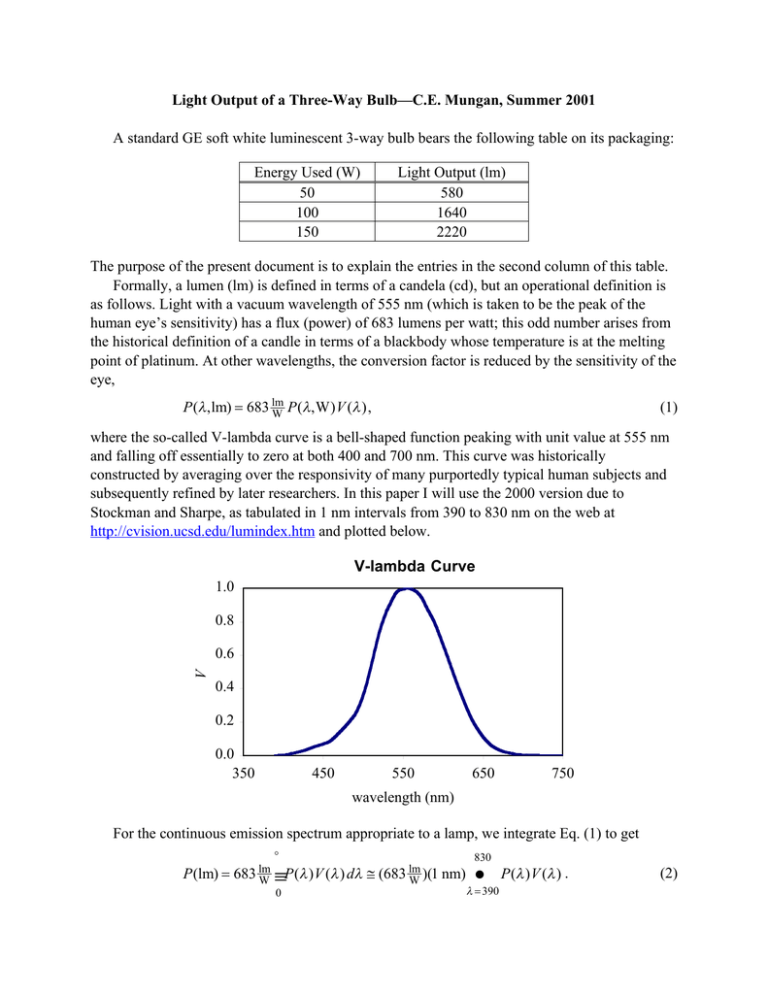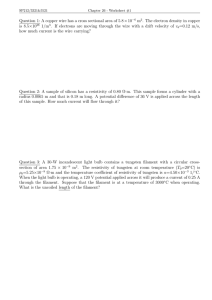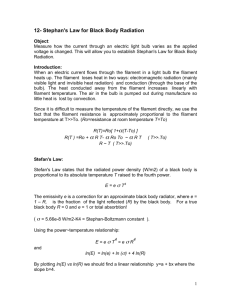Light Output of a Three-Way Bulb—C.E. Mungan, Summer 2001
advertisement

Light Output of a Three-Way Bulb—C.E. Mungan, Summer 2001 A standard GE soft white luminescent 3-way bulb bears the following table on its packaging: Energy Used (W) 50 100 150 Light Output (lm) 580 1640 2220 The purpose of the present document is to explain the entries in the second column of this table. Formally, a lumen (lm) is defined in terms of a candela (cd), but an operational definition is as follows. Light with a vacuum wavelength of 555 nm (which is taken to be the peak of the human eye’s sensitivity) has a flux (power) of 683 lumens per watt; this odd number arises from the historical definition of a candle in terms of a blackbody whose temperature is at the melting point of platinum. At other wavelengths, the conversion factor is reduced by the sensitivity of the eye, P (λ, lm) = 683 lm P (λ, W ) V (λ ) , W (1) where the so-called V-lambda curve is a bell-shaped function peaking with unit value at 555 nm and falling off essentially to zero at both 400 and 700 nm. This curve was historically constructed by averaging over the responsivity of many purportedly typical human subjects and subsequently refined by later researchers. In this paper I will use the 2000 version due to Stockman and Sharpe, as tabulated in 1 nm intervals from 390 to 830 nm on the web at http://cvision.ucsd.edu/lumindex.htm and plotted below. V-lambda Curve 1.0 0.8 V 0.6 0.4 0.2 0.0 350 450 550 650 750 wavelength (nm) For the continuous emission spectrum appropriate to a lamp, we integrate Eq. (1) to get ∞ P (lm) = 683 lm W ∫ P (λ )V (λ ) dλ ≅ 0 830 (683 lm )(1 nm) W ∑ λ = 390 P (λ ) V (λ ) . (2) Assuming the filament emits as a blackbody of surface area As and temperature T, this becomes P (lm) = (683 lm )(1 nm)2π hc 2 As W 830 ∑ λ−5 hc / λ kT −1 λ = 390 e V (λ ) (3) where h is Planck’s constant, c is the speed of light, and k is Boltzmann’s constant. But the total optical power radiated away by the bulb is related to the supplied electrical power (listed in the first column of the table at the beginning of this article) by Popt = Asσ T 4 = ηPelec (4) where σ is the Stefan-Boltzmann constant and η is a conversion efficiency which accounts for the emissivity, conductive and convective heat losses, and absorption of light by the coating and base of the bulb. The second equality in Eq. (4) can be solved for As and substituted into Eq. (3) to give an expression which can easily be computed in Excel, given values for η and T. A quick web search uncovers typical values of η = 82% and T ranging from 2600 to 3000 K. Adopting this value for η and fitting Eq. (3) to the tabulated data by trial and error, one finds T1 = 2750 K for the 50-W filament and T2 = 2950 K for the 100-W one. Encouragingly, these are within the expected range. The last row in our table results when both filaments are on, in agreement with the fact that these entries are simply the sums of the corresponding entries for the two individual filaments. It makes sense that the second filament should burn substantially hotter than the first, because it is dissipating twice as much electrical power. Specifically, we can predict the necessary characteristics of the second filament compared to the first. From the second equality in Eq. (4), 4 R2 L2 Pelec,2 T1 = 1.51, = R1 L1 Pelec,1 T2 (5) since the surface area of a filament is As = 2πRL . On the other hand, ξ2 Pelec = ρL / πR 2 2 R L P 1 + α (T2 − T0 ) = 2.15 , ⇒ 2 1 = elec,2 R1 L2 Pelec,1 1 + α (T1 − T0 ) (6) where ξ = 110 V is the line voltage, and ρ and α = 0.0045 / K are the resistivity of tungsten and its temperature coefficient, respectively, with a reference temperature of T0 = 300 K . Solving Eqs. (5) and (6) simultaneously gives R2 = 1.48 and R1 L2 = 1.02 , L1 (7) i.e., the two filaments should have about the same length but the higher power one should be about 50% thicker in cross section, so as to lower its resistance by the requisite factor of 2. Note that although the second filament puts out almost three times as much useful light, it only consumes double the electrical power of the first filament, because the exitance of a blackbody grows nonlinearly with temperature, as is evident from the graph at the top of the next page. (The slight shift of the blackbody peak into the visible region also helps.) Blackbody Curves spectral intensity (kW/m•m/nm) 3 2 2750 K 1 2950 K 0 0 1000 2000 3000 wavelength (nm) 4000 This implies that if you usually use your 3-way bulb on its highest setting, you would do better to buy a single-filament 150-W bulb instead. Not only would you get more light output (because the average filament temperature would be higher), but the cost of manufacture would be less. Hence, both the initial and the operating costs would be lower per lumen. This is consistent with the fine print on the bottom of the bulb packaging, “To save energy costs, find the bulb with the light output you need, then choose the one with the lowest watts.” Wattage alone does NOT determine the brightness of a luminescent bulb!








